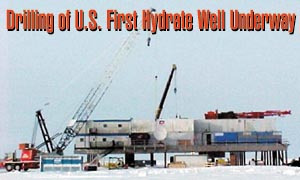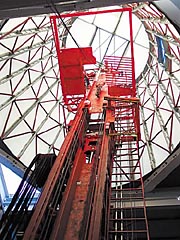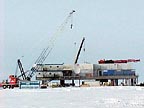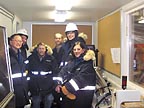

“We saw what could be the drilling platform of tomorrow tapping the energy resource of tomorrow,” says Carl Michael Smith, DOE’s assistant secretary for fossil energy. Smith and other department officials visited the “Arctic Platform,” a lightweight, 100-by-100-foot aluminum drilling platform elevated a dozen feet above the frozen tundra on specially designed steel legs. Based on platforms similar to those used offshore, the Arctic Platform is compact and modular, allowing it to be safely transported by air or with ultra-low-impact vehicles called rolligons. The platform was developed by Anadarko Petroleum Corp., headquartered in Houston. Although the prototype platform is a scaled-down version of the one that would be deployed in future commercial operations, the concept could one day eliminate the need for gravel pads and the temporary ice roads and ice pads that now must be used on the North Slope.
“As President Bush’s National Energy Policy emphasized, the oil and gas industry has made remarkable advances in the last 40 years to shrink the ‘footprint’ of its operations. Anadarko’s Arctic Platform could be the industry’s next major step toward the day when exploration and drilling would leave virtually no lasting trace on the surface,” notes Smith.
The platform has been installed at a site just south of the Kuparuk River field 60 miles west of Deadhorse, Alaska. The methane hydrates project is part of a two-year cost-shared partnership between DOE, Anadarko, Maurer Technology Inc. of Sugar Land, Texas, and Noble Engineering and Development, both wholly owned subsidiaries of Noble Corporation of Sugar Land, Texas. DOE is providing $6 million of the $10.5 million total estimated cost. Deployment and testing of the Arctic Platform is expected to add another $2 million to the project cost with DOE planning to contribute half.

Tom Williams, vice president of Maurer Technology Inc. and the principal investigator for the DOE-funded project, reported that drilling of the hydrate well, designated Hot Ice No. 1, began on March 31 using a slim-hole rig provided by Dynatec, a Utah-based drilling services company. Drilling is to ultimately reach a depth of about 3,000 feet. Methane hydrates are expected to be encountered between 1,200 feet and 2,500 feet deep.
Hydrates are ice crystals that encase natural gas under pressure and at cold temperatures. Known to exist beneath much of the world’s permafrost as well as on or below the ocean floor, hydrates could be a vast storehouse of natural gas that dwarfs other gas resources. On Alaska’s North Slope alone, the hydrate resource has been estimated at 590 trillion cubic feet – many times the 100 trillion to 150 trillion cubic feet thought to exist on the North Slope in more conventional gas-bearing formations.

A specially designed “Drill Smart” system developed by Noble allows project participants to view continuous live data and images from the platform. Anadarko plans to conduct a production test of natural gas from the hydrate formation when the well is completed – again the first ever such test in the United States. “If we can learn how to extract the natural gas trapped in hydrates economically, we could dramatically strengthen the nation’s future energy security,” says DOE’s Smith. “And if we can tap this enormous resource in a way that minimizes the impact on fragile ecosystems, we can take a major step toward both our energy and environmental goals.”


Report Abusive Comment